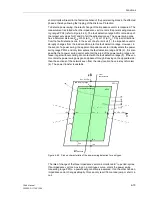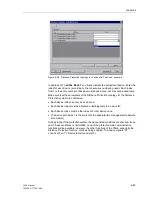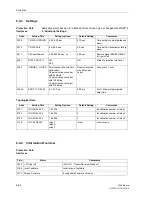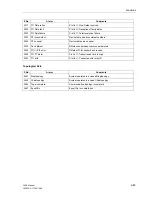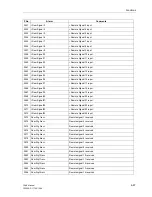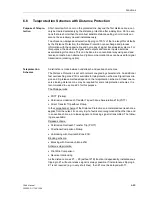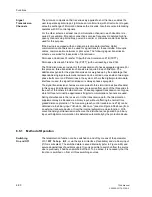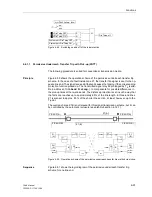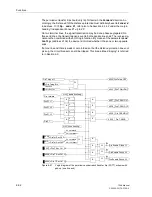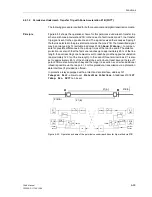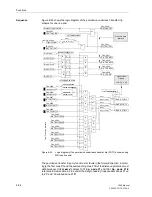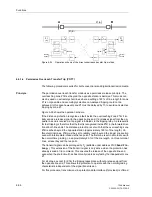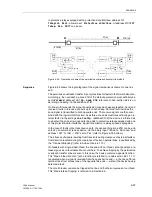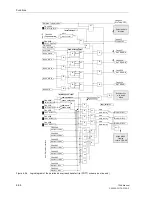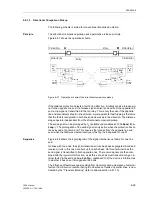
Functions
6-86
7SA6 Manual
C53000-G1176-C156-2
6.5
Transmission of Binary Information (optional)
7SA6 allows the transmission of up to 28 items of binary information of any type from
one device to the other via the communications links provided for protection tasks.
Four of them are transmitted with high priority like protection signals, i.e. very fast, and
are therefore especially suitable for the transmission of external protection signals
which are generated outside of 7SA6. The other 24 are transmitted in the background
and are therefore suitable for any information that does not depend on high-speed
transmission, such as information on the events taking place in a station which may
also be useful in other stations as well. See for Technical Data in Section 10.19.
The information is injected into the device via binary inputs and can be output at the
other ends again via binary outputs. The integrated user-defined CFC logic allows to
perform on both the transmitting and the receiving side logical operations on the
signals and on other information from the device’s protection and monitoring functions.
Like the signal outputs, the binary inputs to be used must be allocated appropriately
during the routing of the input and output functions (see Section 5.2). The four high-
priority signals, arrive at the device via the binary inputs "
>Remote Trip1
“ to
“
>Remote Trip4
“, transmitted to the devices at the other ends and can be re-
transmitted or processed at the receiving side with the output functions
"
RemoteTrip1 rec
“ to ”
RemoteTrip4 rec
“.
If the remote signals are to be used for direct remote tripping, they must be allocated
at the send side via CFC with the function that is to perform the transfer trip at the
opposite side, and at the receiving side, also via CFC, with the „
>Ext. TRIP ...
“
input signals.
The other 24 items of information reach the device via the binary inputs "
>Rem.
Signal 1
“ to ”
>Rem.Signal24
“ and are available under "
Rem.Sig 1recv
“ at the
receiving side.
For the transmission of binary information no settings are required. Each device sends
the injected information to all other devices at the ends of the protected object. Where
selection is necessary, it will have to be carried out by appropriate allocation and, if
necessary, by a link at the receiving side.
6.5.1
Information Overview
F.No.
Alarm
Comments
3541
>Remote Trip1
>Remote Trip 1 signal input
3542
>Remote Trip2
>Remote Trip 2 signal input
3543
>Remote Trip3
>Remote Trip 3 signal input
3544
>Remote Trip4
>Remote Trip 4 signal input
3545
RemoteTrip1 rec
Remote Trip 1 received
3546
RemoteTrip2 rec
Remote Trip 2 received
3547
RemoteTrip3 rec
Remote Trip 3 received
3548
RemoteTrip4 rec
Remote Trip 4 received
3549
>Rem. Signal 1
>Remote Signal 1 input
3550
>Rem.Signal 2
>Remote Signal 2 input
Summary of Contents for siprotec 7SA6
Page 2: ...Siemens Aktiengesellschaft Book No C53000 G1176 C156 2 ...
Page 18: ...xviii 7SA6 Manual C53000 G1176 C156 2 ...
Page 32: ...Introduction 1 14 7SA6 Manual C53000 G1176 C156 2 ...
Page 82: ...Hardware and Connections 2 50 7SA6 Manual C53000 G1176 C156 2 ...
Page 119: ...SIPROTEC 4 Devices 4 25 7SA6 Manual C53000 G1176 C156 2 Figure 4 20 CFC Logic example ...
Page 190: ...Configuration 5 62 7SA6 Manual C53000 G1176 C156 2 ...
Page 652: ...Installation and Commissioning 8 78 7SA6 Manual C53000 G1176 C156 2 ...
Page 724: ...Technical Data 10 56 7SA6 Manual C53000 G1176 C156 ...
Page 800: ...Appendix A 76 7SA6 Manual C53000 G1176 C156 2 ...
Page 866: ...Appendix B 66 7SA6 Manual C53000 G1176 C156 2 ...


